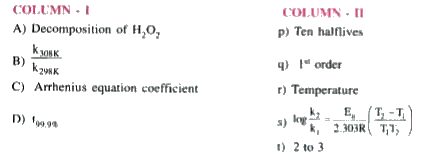The decompostion of N2O into N2 and O2 in presence of Argon follows first order kinetics k=5.0×1011e−2000/T(K). The activation energy is Solution in Telugu
16.628kJmol−1
166.28kJmol−1
166.28Jmol−1
16.628Jmol−1
The correct Answer is:A
K=(5×1011).e−200T,K=A.e−EaRT,−2000T=−EaRT
εa=2000×R=20000×8.3.4=16.628,εa=16.628KJ/mole
Topper's Solved these Questions
- CHEMICAL KINETICSBOOK - AAKASH SERIESCHAPTER - CHEMICAL KINETICSEXERCISE - PRACTICE SHEET-3 (LINKED COMPREHENSION TYPE QUESTIONS)
6 Videos
- CHEMICAL KINETICSBOOK - AAKASH SERIESCHAPTER - CHEMICAL KINETICSEXERCISE - PRACTICE SHEET-3 (MATCH THE FOLLOWING QUESTIONS)
2 Videos
- CHEMICAL KINETICSBOOK - AAKASH SERIESCHAPTER - CHEMICAL KINETICSEXERCISE - PRACTICE SHEET-2 (INTEGER ANSWER TYPE QUESTIONS)
6 Videos
- CHEMICAL KINETCSBOOK - AAKASH SERIESCHAPTER - CHEMICAL KINETCSEXERCISE - EXERCISE - 3.2
45 Videos
- CHEMICAL THERMODYNAMICSBOOK - AAKASH SERIESCHAPTER - CHEMICAL THERMODYNAMICSEXERCISE - Additional Practice Exercise
54 Videos
Similar Questions
For a chemical reaction A→ products, the following equation is found to be followed, logK=16.398−2800T
Arrhenius factor for the reaction is ______
View SolutionMatch the following columns

View SolutionFor a reaction the graph drawn between half life period and reciprocal of initial concentration(1/a) gives a straight line with positive slope. The magnitude of the slope is 500 and iniital concentration of the reactant is 2M. If the initial rate of the reaction is represented as x×10−3 units, then the value of x is _____________
View SolutionDiscuss on the kinetic spontaneity of a chemical reaction. Is a slow reaction spontaneous? Why?
View SolutionWhich among the following is not an exact differential?
View SolutionGive the change in bond order in the following ionisation process?
i. O2→O⊕2+e− , ii.N2→N⊕2+e−
View SolutionThe decomposition of N_(2)O in N_(2) and O_(2) in presence of gaseous argon follows II order kinetics having K=5xx10^(11) e^(-29000//T) . Find out energy of activation and rate constant at 27^(@)C . Also evalute Arrhenius parameter.
View SolutionThe decomposition of N_(2)O into N_(2) & O_(2) in presence of gaseous argon follow second order kinetics with k = (5.0 xx 10^(11) L "mol"^(-1) s^(-1)) e^(-(41570)/(T))" " (K stands for Kelvin units). The energy of activation of the reaction is
View SolutionThe decomposition of N_(2)O into N_(2) and O_(2) in presence of gaseous argon follows second order kinetics with rate constant, K=2.0 xx10^(11) e^(-30000K//T)mol^(-1)s^(-1) . The pre - exponential factor and the enrgy of activation are respectively (R=2 cal K^(-1) mol^(-1))
View SolutionThe decomposition of N2O into N2 and O in the presence of gaseous argon follows second order kinetics with
k=(5.0×1011L mol−1s−1)e−29000K/T
The activation energy for the reaction Ea is
View SolutionThe decomposition of N_(2)O into N_(2) and O in the presence of gaseous argon follows second kinetics with k=(5.0xx10^(11) L "mol"^(-1) s^(-1))e^(-29000 K//T) The energy of activation is
View SolutionThe decomposition of N_(@)O into N_(2) and O_(2) presence of gaseous argon follows second order kinetics with k=(5.0xx10^(11)"L mol"^(-1)s^(-1))e^((-41570K)/(T)) (K stands for Kelvin units). The energy of activation of the reaction is :
View SolutionStatement-1: Many reaction occuring on solid surface are zero order reactions Statement-2: N_(2)O(g) overset("Au")rarr N_(2)(g) +(1)/(2)O_(2) , rate =k[N_(2)O]^(0)=k =constant is a zero order reaction.
View SolutionThe correct order of acidic strength of OXides of nitrogen is \(NO \(N_{2}O \(NO \(NO < N_{2}O < N_{2}O_{5} < N_{2}O_{3}< N_{2}O_{4}\)
View SolutionThe rate of the reaction 2N2O5→4NO2+O2 can be written in three ways
−d[N2O5]dt=k[N2O5],d[N2O5]dt=k'[N2O5]d[O2]dt=k''[N2O5]
The relationship between k and k' and between k and k'' are
View Solution
